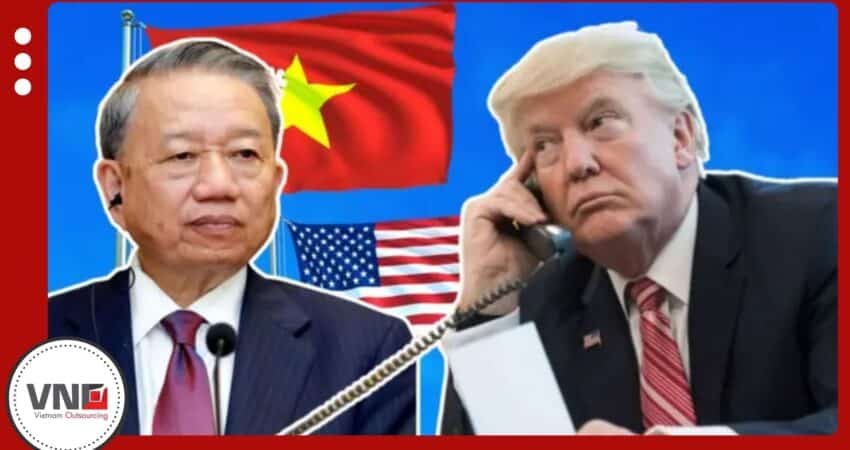- July 3, 2025
- Daniel Pham
U.S. and Vietnam Reach Landmark Trade Agreement Amid Tariff Restructuring
Table of Contents
On July 2nd, at 8:00 PM Vietnam time, General Secretary Tô Lâm held a high-level phone call with U.S. President Donald Trump to discuss bilateral relations and finalize negotiations on a reciprocal trade agreement. The conversation marked a significant step forward in strengthening U.S.–Vietnam economic ties as both leaders endorsed a new framework aimed at fostering fairer, more balanced trade.
Key Outcomes of the Dialogue
Both leaders expressed strong satisfaction with the positive momentum in U.S.–Vietnam relations. They welcomed the successful conclusion of a Joint Statement on a Reciprocal, Fair, and Balanced Trade Agreement, achieved through intensive negotiations between their respective trade delegations.
President Trump highlighted Vietnam’s commitment to granting preferential market access for U.S. goods, notably large-engine automobiles—an industry that holds substantial export potential for the U.S. In return, Trump announced that the United States will significantly reduce reciprocal tariffs on many Vietnamese exports, alleviating some of the pressure caused by the 46% blanket tariff initially proposed under his trade protection plan.
Details of the Trade Deal
In an official statement released on his Truth Social account, President Trump stated:
“Vietnam will pay the United States a 20% tariff on any and all goods sent into our Territory, and a 40% tariff on any Transshipping. In return, Vietnam will give the United States TOTAL ACCESS to their Markets for Trade… at ZERO Tariff.”
This marks a historic shift in U.S.–Vietnam trade dynamics. For the first time, Vietnam will open its market entirely to U.S. exports—a move that could benefit sectors such as automobiles, agriculture, and high-tech goods.
Additionally, the agreement aims to curb transshipment practices—the process where goods from a third country are rerouted through Vietnam to bypass U.S. tariffs. These goods will now be subject to a 40% tariff, a clear signal that both nations are committed to transparent and rules-based trade.
Vietnam’s Strategic Requests
During the call, General Secretary Tô Lâm proposed that the U.S.:
Officially recognize Vietnam as a market economy, which would end the current non-market classification that often results in higher anti-dumping duties.
Lift export restrictions on certain high-tech items, enabling Vietnam to further its development goals in innovation and advanced manufacturing.
Both leaders agreed to pursue broader strategic cooperation across multiple sectors—particularly science and technology—while deepening diplomatic engagement through regular high-level exchanges and visits.
President Trump warmly received General Secretary Tô Lâm’s invitation to visit Vietnam, expressing his desire to reunite soon.
Implications for Global Trade
This agreement comes just days before a 90-day tariff reprieve—imposed in April 2025—was set to expire. Without a deal, Vietnamese exports to the U.S. faced a looming return to a 46% tariff rate. Now, with a 20% tariff agreed upon and potential exemptions for select industries, Vietnamese exporters have gained valuable clarity and relief.
However, concerns remain in industries such as apparel and electronics, where a 20% tariff may still erode competitiveness. Companies relying on Vietnam’s manufacturing infrastructure will need to re-evaluate cost structures and supply chains.
The S&P 500 reacted positively to news of the deal, reflecting optimism about the potential for reduced trade friction. Still, analysts caution that implementation details remain unclear, as the exact timeline and enforcement mechanisms for the deal have not been officially released.
What This Means for VNO Clients
For international buyers working with Vietnam Outsourcing Pte Ltd (VNO), this trade agreement creates a more favorable and stable trade environment between the U.S. and Vietnam. Here’s how:
Reduced Tariff Risk: With the blanket 46% tariff off the table, VNO clients can expect lower import duties on Vietnamese-manufactured components, assemblies, and metal parts—improving price competitiveness.
Improved Supply Chain Certainty: The deal minimizes disruptions and gives VNO’s partners greater confidence when forecasting costs and managing procurement timelines.
Stronger U.S. Market Access for VNO Suppliers: With Vietnam now granting tariff-free access to U.S. goods, reciprocal treatment is more likely in practice—potentially accelerating regulatory clearance and customs efficiency for Vietnamese exports.
Better Policy Alignment for Long-Term Growth: Vietnam’s request for recognition as a market economy and reduced high-tech export restrictions would open doors to more advanced manufacturing capabilities, allowing VNO to scale up offerings in precision components and engineered solutions.
Strategic Advantage Over Competitors: As China faces ongoing scrutiny for transshipment practices, sourcing directly through certified Vietnamese suppliers like VNO offers a safer and fully compliant alternative for American and EU importers.
Bottom line:
This agreement not only reaffirms Vietnam’s role as a reliable manufacturing hub but also strengthens the positioning of VNO as a key bridge between Western buyers and high-quality Vietnamese engineering suppliers.
Conclusion: A Turning Point for U.S.–Vietnam Trade
The U.S.–Vietnam trade agreement marks a major milestone in bilateral economic relations, offering mutual benefits while addressing long-standing structural issues. With Vietnam opening its market and the U.S. easing tariff pressure, both countries stand to gain from expanded trade and stronger diplomatic engagement.
As the global trade landscape continues to evolve, this deal reinforces Vietnam’s strategic role as a trusted partner in Asia and signals a new chapter of comprehensive economic cooperation between the two nations.



